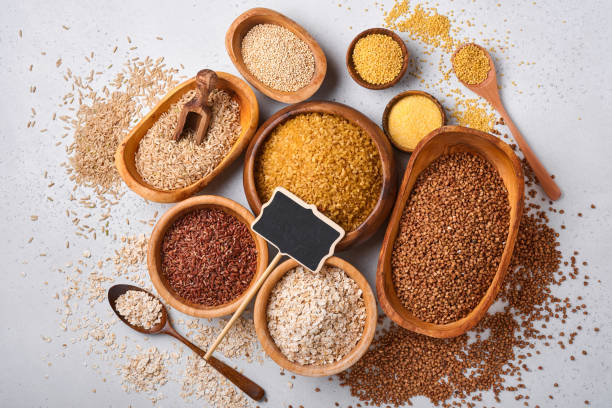Today, in this era of fast and processed food, ancient grains have once again returned to the tables of health-focused people. Modern wheat has been heavily hybridized and altered, whereas these traditionally grown grains remain relatively untouched. They are grains that humans have grown and consumed for thousands of years, but why are ancient grains popular in modern diets all over again? Here are some rare insights to help you understand and delve into the secrets of effective nutrition in these powerhouses.
What Are Ancient Grains?
Ancient grains are those that have been cultivated for millennia and have retained their original genetic makeup. They’re often more nutrient-dense than modern wheat, they also have tons of vitamins, minerals, fiber, and protein. Popular examples include quinoa, amaranth, teff, millet, and spelt, with lesser-known varieties like kamut, einkorn, and freekeh gaining attention for their health benefits.

Unlike modern wheat, ancient grains have not been altered to increase yields or gluten content, which makes them easier for some people to digest. Rare research suggests that people with non-celiac gluten sensitivity may tolerate these grains better due to their lower gluten content and diverse fiber composition.
The Nutritional Power of Ancient Grains
One of the rarest findings about ancient grains is their impact on gene expression. Research shows that the phytochemicals in ancient grains can regulate genes associated with inflammation and oxidative stress, potentially protecting against diseases like heart disease, diabetes, and even cancer.

Ancient grains are also prebiotic-rich, meaning they promote the growth of beneficial gut bacteria. Teff, for example, is high in resistant starch, which is a type of fiber that feeds gut bacteria and improves digestion. This supports gut health, boosts immunity, and can even enhance mental well-being.
Kamut, another lesser-known grain, is rich in omega-3 fatty acids and selenium, an antioxidant that is very beneficial to thyroid function and protects the body from oxidative stress. Kamut’s ability to lower cholesterol and reduce inflammation makes it especially beneficial for heart health.
The resurrection of ancient grains is part of the whole foods movement, driven by more consumers seeking options to processed food. Despite these grains having high fiber, protein, and important nutrients, they will be a perfect choice for those following a low carbohydrate vegetarian diet plan.

In plant-based diets especially, ancient grains are an essential part. Quinoa — Since more are cutting back on meat, grains like quinoa are a great source of complete protein, providing our bodies with all nine essential amino acids. This makes them a good value for vegetarians and vegans that may have difficulty finding quality, plant-based protein sources. Innovative chefs are also playing with ancient grains, using them as a vehicle for nutrient–and flavor–dense foods.
Roasted green wheat is being used to make salads, soups, and even burgers for its chewy texture and smoky taste. This is also driving consumer demand for einkorn flour among home bakers seeking less processed, more nutrient-rich alternatives.
Rare Insights: Ancient Grains and Sustainability
On the sustainability side, ancient grains represent something of a win/win. While some are still centered around gluten-free options, most of these grains – including millet and sorghum – boast natural pest- and drought-resistance qualities that make them excellent candidates for farming in areas affected by climate change. These need fewer chemical inputs, protecting the environment and promoting biodiversity.
They help restore soil health through ancient grains. Ancient grains like spelt or amaranth help regenerate the soil, allowing for better crop rotation and less erosion than monoculture crops such as modern wheat and corn. It contributes to the fertility of the soil, enhancing the nutrition value of its grains.
20 Benefits of Including Ancient Grains in Your Diet
- Very high in fiber, which aids digestion and prevents constipation.
- Rich in protein, particularly quinoa, which contains all essential amino acids.
- Lowers cholesterol levels, especially Kamut and barley.
- Abundant in antioxidants that protect against oxidative stress.
- Supports heart health by reducing inflammation.
- Enhances gut health by acting as a prebiotic.
- May reduce the potential risk of chronic diseases like diabetes and heart disease.
- Provides sustained energy due to their low glycemic index.
- Gluten-sensitive individuals may tolerate them better than modern wheat.
- Contributes to weight management by promoting satiety.
- Packed with essential minerals like magnesium, iron, and zinc.
- Improves bone health due to high calcium content in grains like teff.
- Boosts immunity by supporting a healthy gut microbiome.
- Reduces blood pressure, particularly with grains like barley.
- May improve mental clarity and cognitive function.
- Supports sustainable clean agriculture by reducing the need for chemicals.
- Contributes to soil health through diverse farming practices.
- Naturally resistant to pests, reducing the need for pesticides.
- Drought-tolerant crops like millet help fight climate change.
- Versatile and easy to be incorporated in a variety of dishes.
Conclusion
Not just the health fad that many people consider it to be, ancient grains provide much more than just health benefits. This makes them a sustainable and nutrient-dense choice for modern diets, especially as we transition from monoculture grains with little human intervention to more plant-centric, whole foods. Add Ancient Grains to your plate for a better experience and environment.
Thank you for reading my article on the “Ancient Grains in Modern Diets“. I’d love to hear your thoughts or comments below.

